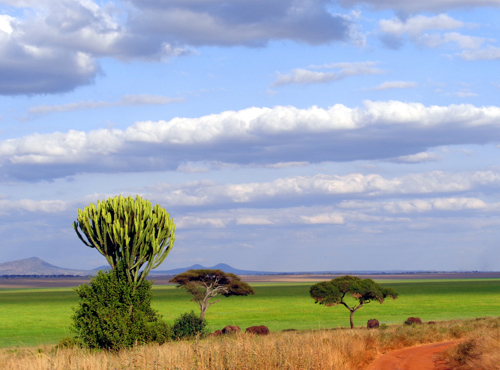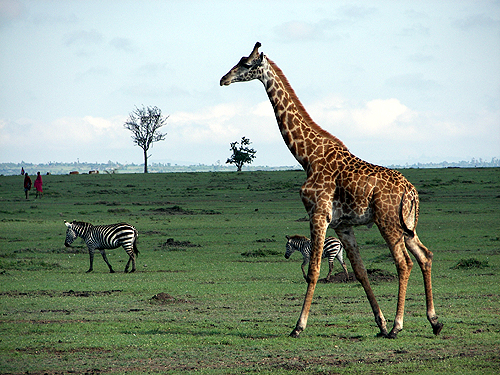 Jim is in Botswana and will post a blog as soon as wifi becomes available. Stay tuned!
Jim is in Botswana and will post a blog as soon as wifi becomes available. Stay tuned!
Category: OnSafari
OnSafari: The Cape
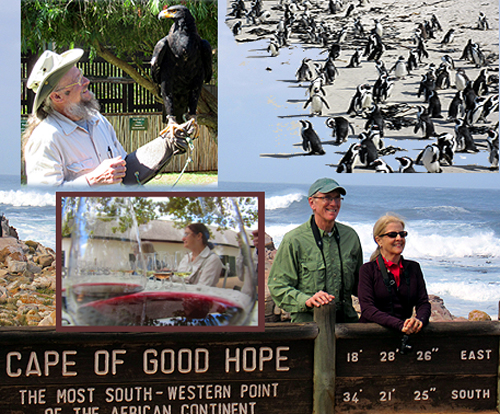 Our final days in The Cape included wonderful touring of the Cape of Good Hope and the wine country.
Our final days in The Cape included wonderful touring of the Cape of Good Hope and the wine country.
Although it was overcast for most of the day at The Cape, that doesn’t reduce too much the fantastic scenery. Starting at Cape Town’s popular Camp’s Bay, the group spread out wide getting pictures of this wide and beautiful white-sand beach.
Although I know that most Cape Townians think of Camp’s Bay as their principal swimming beach, I can also tell that the vast majority of people on it are foreigners and snowbirds from Europe. There are hundreds if not thousands of time-shares and luxury rental condos here, and tons of coffee shops and cafes.
This was a particularly vibrant weekend as it’s the week before Easter when many of the long-distance visitors first arrive.
We then began the spectacular Chapman’s Peak Drive. This cliff-hanging tourist route to the Cape of Good Hope passes over Hout Bay, and as usual, the black “shark” flag was waving, so the massive white-sand beach was mostly empty. The scenery here is breath-taking.
But there were remnants of last year’s fires, and while I’ve been coached by people that this is a normal cycle, I think it’s fair to say last year’s was extreme. It canceled the Cape Mountain Bike Marathon – the first time ever, and later we would here from some wineries how they were devastated.
But today it was drizzling! The drought is broken, although there is still a moisture deficit as El Nino slowly fades.
We rode the “Flying Dutchman” to the overlook of the two great oceans, and I recounted to everyone the “Age of Discovery” and fascinating history of the 1400-1500s culminating in Bartolemeu Dias’ rounding of these turbulent seas.
Everyone gazed into the vast ocean that continues to Antarctica, a distance nearly ten times that from where Antarctic ocean voyages leave Ushuaia in Argentina!
We then went to the penguins at Boulders and that’s always so much fun! They were out in full force, if you can say that of a dismal looking and slow-moving penguin! The place was packed, nearly shoulder to shoulder with tourists, but there were hundreds of penguins on display, completely oblivious to their admirers.
Today we visited Eagle Encounters, one of my favorite stops in The Cape. This remarkable raptor rehabilitation center has literally saved the endangered Cape Vulture. Our special private tour by falconer Donald is such fun!
Starting with the Jackal Buzzard, Donald flew Cape Vultures, a barn owl, a gymnogene, a rock kestrel and finally the not-native American vulture that was confiscated from a collector in Cape Town.
As he himself said, the birds all “love him” and that’s why he can show them off – how they fly, how they look and how obediently they stand on our heads!
We had two wine tastings, one at the Cape’s second oldest vineyard and a full cellar tour at the lovely Lanzerac where we’re staying. The group also had several hours in the lovely Afrikaans town of Stellenbosch, so they could visit restored homes from the 17th Century and enjoy some real Afrikaans food for lunch!
Tomorrow we finally get into the bush of Botswana. Stay tuned!
OnSafari: Apartheid
 Apartheid is in the spotlight of most sightseeing for visitors to South Africa. It’s not a pleasant tale, but visits of the sort my group took to the Apartheid & Hector Pieterson Museums in Johannesburg and the District Six Museum in Cape Town are uplifting.
Apartheid is in the spotlight of most sightseeing for visitors to South Africa. It’s not a pleasant tale, but visits of the sort my group took to the Apartheid & Hector Pieterson Museums in Johannesburg and the District Six Museum in Cape Town are uplifting.
Because today’s story of apartheid is how it was ended, and how it must be understood and remembered to prevent it from happening again … anywhere.
Those in my group who visited District Six in Cape Town were led through those dark years in the “Mother City” by resident Joe Schaffers who recounted his personal story.
District Six was one of the oldest and most integrated communities in Cape Town. Residents were often fifth or sixth generation residents and from a variety of socio-economic backgrounds.
They were professionals and blue collar workers. They were commuters and local tradespeople. They embodied an enormous variety of religious groups, from Muslim to Jewish to Christian to Sikh and others.
Borne of the earliest days of Cape Town, many District Six residents carried at least a bit of the legacy of the 18th Century Malay slaves imported to The Cape by the Dutch colonists, although before the 1960s slavery was a topic residents were more prone to hear in discussions of early American than early South African history.
But apartheid changed all that.
“Digging Deeper” is the permanent exhibition theme of District Six as it tirelessly reminds South Africans and visitors alike of the barbaric attempted destruction of this community of 60,000 residents – a tenth of the city’s population in 1966.
The district became an official political municipality of Cape Town in 1867, nearly a century after its earliest residents settled there. Then, almost exactly 100 years later in 1966 the South Africa apartheid government advised the 1900 families living there that they were being “removed” – by designated race – to ghettos outside the city.
They were to be separated and removed so that whites controlling the apartheid government could develop this prime real estate in the city for themselves.
To me personally one of the most stinging parts of this story is that there was hardly any protest by District Six residents. There were frantic attempts by many to be excluded from the removal, or to be granted new race designations to assure removal to better ghettos, or to preclude the action by the government by moving elsewhere themselves, first.
But there were no protests – violent or otherwise – as characterized the opposition to apartheid in Johannesburg (Soweto).
Those of us who visited the Apartheid and Hector Pietersen Museums learned of these heroic oppositions. All of them began non-violently, but when police shot and killed 600 secondary school students in June, 1976, for protesting a change of language instruction from English to Afrikaans, the bloody imprint to revolution was intractably laid.
The individual stories in the actual places where this history took place is a moving experience for anyone. Personally I think it’s uniquely important today.
The immigration problems effecting Europe, much less South Africa itself (see this earlier blog of mine), and the immigration issue central to the American political campaign are all analogous to the issues that birthed apartheid.
“Apartheid” is an Afrikaans construction meaning “apartness,” a belief that society best develops when its people are separated by race. Apartheid was brutal, effective, and “legal.”
Apartheid was condoned not just by the majority of white South Africans, but by many Americans like Ronald Reagan and Pat Buchanan. It was opposed by many, if not more Americans, too, like Richard Lugar and Ron Dellums.
But apartheid has absolutely zero place in modern societies. Perhaps when the Neanderthals were fleeing the Denosovians it might have been useful. But the world today is both actually and conceptually far too congested to think we can live and develop apart from one another.
I’m extremely proud of my fellow travelers, today. Most vacationers don’t schedule much if any of their precious R&R to enter the darknesses of the past, but that’s what’s necessary for any traveler who visits South Africa and wants to understand it.
OnSafari: The Blue Train
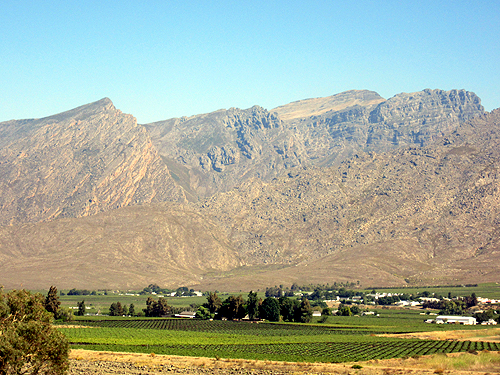 For the last two days we’ve been traveling on the Blue Train, one of the world’s premiere luxury trains.
For the last two days we’ve been traveling on the Blue Train, one of the world’s premiere luxury trains.
We boarded the 10-car exclusive train in Pretoria and headed south through the heavy industrial areas of the Transvaal. I think people are impressed by the extent of South African industry, but what was a surprise to all of us was the massive Vereeniging Steel Works which went on and on as the train rushed past.
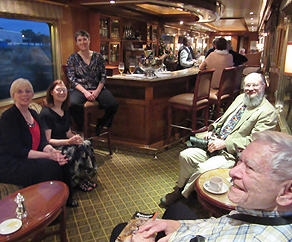
Soon, though, we were entering the great southern end of the country’s massive bread basket. The first part was almost as depressing as seeing the closed steel plant, because the area has been suffering a severe drought. For the first time in most people’s memory, South Africa will be importing corn this year.
But as if to turn around our sinking moods, we entered a fierce thunderstorm with lightning and hail. It lasted most of the afternoon, and as the train left the heavy overcast the beautiful sunset introduced us to the beginning of the Great Karoo.
The train has been operating since the 1920s in one form or another. There is now another luxury train, Rovos Rail, but I prefer this less pretentious and more business-oriented service.
Prices are similar and with today’s extremely depressed Rand, the train was so full that people were waiting outside hoping that we didn’t arrive!
After your private butler takes you into your elegant suite and shows you all the bells and whistles, the train begins and I for one, ordered a big pot of tea with cold milk!
It came in elegant, heavy silver and was among the best tea I’ve ever had in South Africa!
The group would meet from time to time in the Club Lounge car. All drinks, even premium champagne and spirits are included, and when I entered the car one table was piled high with sweets and pastries.
Lunch is as big as dinner (unfortunately) but it gave us all the opportunity to try a variety of premium South African wines. The food was absolutely exquisite.
Wifi depended upon which area the train was speeding through, but if the area had wifi, we did, too.
I returned from dinner with my bed beautifully made and three large chocolates on the pillow!
I woke myself so that I could see sunrise over the Karoo. The Karoo is South Africa’s Mojave desert. I watched a number of raptors over the massive landscapes plus saw gemsbok, steinbok and springbok … and, of course, thousands of angora sheep.
What was most amazing were these sheep farms. A windmill provided water and solar panels provided electricity and they were all built near the train tracks and spaced, oh, maybe 25 miles apart!
It is outstandingly beautiful in a very lonely way, and I just couldn’t help but try to imagine the lives of these remote farmers. I was able to follow the route nearly mile by mile on my computer using wifi, and almost all of the handful of Karoo towns were settled in the mid 1800s by Boer trekkers.
After our final lunch we left the Karoo, climbed the jutting Swartberg Mountains, went through several tunnels (one 8 miles long) and entered a completely new world: the wine country, starting around Worcester.
It’s a landscape hard to beat anywhere in the world: lush, green vineyards under the cutting and ancient bare granite of the mountains.
We pulled into the “Mother City” about 35 hours after we left. What a wonderful, happy, relaxing and palate-extraordinary journey!
OnSafari: Joburg & Soweto
 We spent the entire day touring Johannesburg and Soweto as I began my annual Cape/Bot safari.
We spent the entire day touring Johannesburg and Soweto as I began my annual Cape/Bot safari.
We drove a lot, though the super luxurious areas and into the slums. We visited outstanding museums, including the Apartheid Museum and Hector Pietersen Museum. It’s an eye-opener for most first-time visitors.
I don’t think there’s any place in Africa that suffers from as many misconceptions and stigmas as Joburg. The city is immense, chaotic, congested and the smog got to me, today.
But parts of it like the suburb of Sandton where we’re staying are more luxurious than many of the finest suburbs of big cities in America. There are more private swimming pools per residence in Joburg than in Dallas. You’ll see more Benz’ and Porches than in San Francisco.
But we also saw the decaying side of the city that authorities are trying so hard to rehabilitate. The end of apartheid resulted in situations few negotiating its end anticipated.
The brilliance of the new constitution meant that refugees were welcome, and boy did they come literally by the hundreds of thousands! Downtown Joburg today is where these Nigerians, Somalians, Chadians, Zimbabweans and so many others eke out a difficult existence.
Technically, they’re all illegal, but also technically under the new constitution, they have the right to remain and enjoy public services if they weren’t detained when first entering.
So the city decayed rapidly. Crime escalated. South Africa doesn’t have the resources that say, Germany or Sweden has to provide for these immigrants and so they developed ghettos of extreme poverty and depravity.
I think it’s turning around, and some major banks and corporations like Anglo-American are relocating into the city center.
There are equally reversed misconceptions of Soweto. Most of Soweto is composed of lovely residential districts of what local residents fondly refer to as “matchbox houses.” They are all tidy, colorful, maintained and the dozen or so of separate districts all seem to display some unique style.
Commerce is booming in Soweto, from manufacturing industries to mom-and-pop corner stores. We lunched at a traditional restaurant called Sakhumzi while being entertained by some exceptional singers and dancers. “Sakhumzi” means “to build” or “builder” and is the perfect way to characterize Soweto, today.
But it was the power of the museums of the area that everyone will remember. Of course they all focused on the oppression of apartheid, so it was a rather heavy tour.
In addition to the Apartheid Museum, we visited Nelson Mandela’s first home in Soweto, the Catholic Church in Soweto which was essentially the gathering place for everything political, and the Hector Pietersen Museum.
This museum is named after the youngest child (he was 13) of 600 students shot by police in the June, 1976 Soweto uprising.
I’ve been to all these place before, but it was also a very special day for me. This is the day my state, Illinois, votes in the presidential primary. The parallels of my country today with pre-apartheid South Africa are chilling.
Jan Smuts and J.M.B. Hertzog were both conservative Afrikaners (like say, Bush and Romney) who were ousted from power by a tricky mad dog, D.F. Malan, who like Trump rose to power on an angry and confused constituency. Malan once in power quickly crafted what became one of the most onerous, oppressive societies in history.
I really think it is a remarkable comparison. The realization sent chills down my spine.
Tomorrow we board the Blue Train, one of the most magnificent, luxurious trains on earth, for our 2-day journey to the Mother City, Cape Town! Stay tuned!
OnSafari: 4 Days in the Serengeti
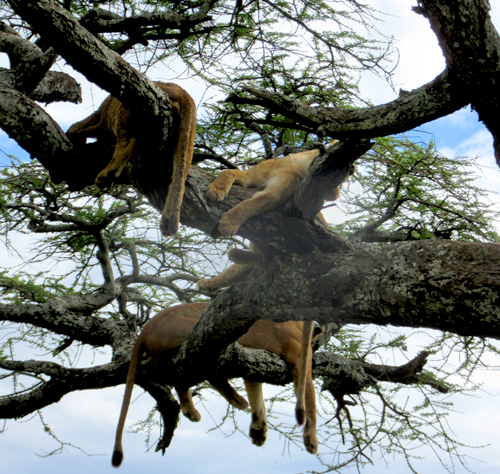 Our last two days of game viewing in the central Serengeti were fabulous! Lion hunts, five leopards, rare birds and some of the most magnificent scenery on earth!
Our last two days of game viewing in the central Serengeti were fabulous! Lion hunts, five leopards, rare birds and some of the most magnificent scenery on earth!
We left Ndutu and headed for the Moru Kopjes. This is the prettiest place in the Serengeti, with lovely small bush forests and meadows nestling giant granite kopjes that sculpt all sorts of shapes and sizes into the landscape.
My principal object in going is to visit two sacred Maasai sites: the cave paintings where newly initiated warriors are instructed by the outgoing warriors of their tasks and responsibilities, and Ngong Singing Rock, the legendary place that Bernard Gzimak convinced Maasai residents to leave much of what is now the Serengeti in 1972.
We did that, and it’s both heart-breaking and hopeful to hear the tales that grew the Serengeti at the expense of Maasailand.
But we also saw a rhino in the Moru! Now that’s something, because truly wild black rhino are about as rare a wilderness event outside of the Ngorongoro Crater that anyone can have, today.
And in the Moru we saw ten lions in two trees! It was actually quite hilarious and was right on the main Sopa road off the main Seronera road just after entering the Moru. The family had obviously finished off a pretty significant kill, because every one of their bellies was big.
After a lion kills and feasts (often increasing body weight by a quarter to a third) it has to flood itself with water. I can only imagine how painful that must be. Then the lion starts to hyperventilate. Besides running down a zebra at break-neck speeds, digesting hunks of unchewed meat is the hardest thing a lion body has to do!
Then, it tries to sleep. In this case, ten of them were flung about two trees on opposite sides of the road, all looking terribly uncomfortable. It was hard to position the belly so that it didn’t pull them off the branch, and once positioned, the rapid breathing made the branches move up and down as if the tree were alive!
In our last two days in the Serengeti we also saw five leopard. I hesitate to say this, because I guide many safaris to many of the same places where we never see a single leopard!
We also watched a lion hunt from start to finish and racked up more than 30 lions in three days of game viewing. For all you prospective first-timers to Africa, beware: that’s very unusual.
I think you can figure out by now that this was an extraordinarily successful safari, and I’m pressing myself to figure out why.
There’s no question that luck has a lot to do with it. But I know for certain from this group that client attitudes might be just as important.
We averaged 10-12 hours of game viewing each day. When I say that, I get myself tired, but we didn’t feel tired at the time. Everyone was so enthusiastic and the wilderness and its magnificent animals so beckoning. This is my favorite time of the year, when the rains that began at the beginning of the year get properly organized.
So the veld is so incredibly beautiful. The skies, especially at sunset, are so heart-thumpinginly magnificent. And the dramatic, loud and powerful storms disrupt hardly a couple hours of the day, a break normally at lunch time that we really need.
There are baby animals everywhere. We found one group of female wildebeest and it seemed like virtually every one had a calve! We saw baby giraffe that looked at us with as much curiosity as we had looking at them, and cheetah cubs hardly a couple weeks old that walked up to our vehicle almost meowing!
The Serengeti is my favorite place in the world and it lived up to every hope and demanding expectation I had for this marvelous group of people traveling with me.
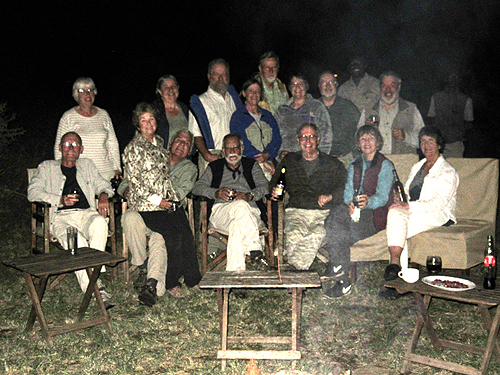
OnSafari: Serengeti Day 1
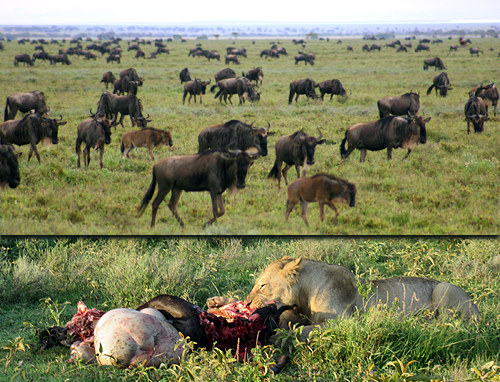 Day 1 of 4 in the Serengeti: a lion kill, a cheetah kill, and most exciting of all, a reasonable hunk of the great migration!
Day 1 of 4 in the Serengeti: a lion kill, a cheetah kill, and most exciting of all, a reasonable hunk of the great migration!
The reason we found the migration was because the people I’m with are so incredibly enthusiastic. It’s that simple!
I expect that most of the migration is in the center of the park where we go, tomorrow. We’re currently in the far southwest. The information we garnered from the many other drivers here at Ndutu Lodge, as well as from rangers and what we could pick out of the radio traffic, suggested no large herds in this area.
So we headed out at dawn ready for anything … but the great herds.
We saw five cheetah and ten lion including a lion kill and a cheetah kill plus an unsuccessful cheetah hunting a baby wildebeest. That event failed when the mother wildebeest intervened at the last possible moment.
We had a fabulous breakfast on the plains packaged for us in Ndutu’s famous picnic baskets and we’d been out for five hours. We were an hour from camp so I was ready to call it a morning and return for lunch, but…
…Justin, one of my outstanding long-serving driver/guides, heard over the radio that 3 days previously wild dog had been seen another 90 minutes out from the lodge. Was anyone interested? That was in a pretty remote place.
The chances seemed extremely thin. It could mean at least an 8-hour game drive and no lunch!
Soon the entire group, all three vehicles was on board with the idea, and off we went – in the opposite direction of lunch!
Hardly a half hour later I began to see a very large number of wildebeest.
Most of the wildebeest we had seen until now were in wildly dispersed migratory files heading to the center of the park, where we expect to be tomorrow.
Twice, lost baby wildebeest had attached themselves to us, once on the Lemuta plains and once this morning at breakfast.
On the plains the poor 2-week old ran itself close to death trying to keep up with our speedy Landcruiser. We finally led it to a water hole with hyaena looking on.
This morning we were packing up breakfast when another two-week old showed up blarting. It pranced back and forth hardly 20 feet away from us. There were no other animals near us, much less its mother.
There are all sorts of reasons baby wildebeest get separated from their mothers, but one important one is that the migratory files are moving so quickly; and they were all moving in the same direction. I was pretty convinced that the big herds were all in the center off the park.
But before long on our extended trek to find wild dog we were among very large herds, not just of wildebeest, but zebra, gazelle and all sorts of other animals. We probably passed 500 eland.
Everything was located in and around the Kerio Valley, west southwest of Ngorongoro not really too far from the village of Endulen. Nobody suggested this area to us. None of the radio traffic or driver/guides or rangers even thought that part of the migration would be here.
The main reason no one knew about this is precisely because no one travels to this place! It’s deemed far too far from established tracks or lodges. The only reason we found it, is because my group is so tirelessly enthusiastic!
Five people have been with me for 30 days, yet they were among those lobbying for staying out!
So no, we didn’t see the wild dog. My predictions on that count were right: the chances of finding some family of animals in a place they were three days previously is ridiculously slim.
But it was just the excuse these wonderful adventurers needed to stay out, go further, do more. And what a reward we got!
OnSafari: Crater Drama
 Forty very large elephant running six miles from one northern end to the southern end of the crater intersected the road endangering our early morning game drive.
Forty very large elephant running six miles from one northern end to the southern end of the crater intersected the road endangering our early morning game drive.
We stopped to watch, and their trumpeting exploded all around us. The matriarchs of each of the four families turned to us, opened their ears and two charged!
Youngsters, one hardly a week old, didn’t know where to turn as the mothers confronted us. We held our ground; they were mock charges, and I knew that we couldn’t run from them if it were anything else.
We stayed quiet as they ran far past us, their trumpeting continuing and diminishing, the beautiful song of the red-naped lark finally penetrating their screeching.
The stillness of the early morning crater was forever unsettled. What had happened to them? I don’t know. It was only just after sunrise. No one else was on the floor but us. What had set them off?
It would be easy to say someone had tried to poach them, but that’s unlikely. Poachers don’t dare try to take down an elephant in such a large and wild group. We’ll never know. Perhaps they were from some distant place and had never seen the vast plains of the crater, moving their lives from one forest to another.
I just don’t know. But it was super powerful and heart-thumping. I just hope in the forests beyond the crater rim they’ll find some peace…
The rest of the morning in the crater was beautiful, perfect and normal. That’s quite abnormal!
About 25,000 animals were scattered marvelously among the mostly green plains and lush and verdant crater rim sides. There was a baby wildebeest for every two adults, 25 fat and sassy lions some licking deep hunting wounds, a giant rhino, hundreds of buffalo, black-backed and golden jackals, eland and hartebeest, hippo and elegant birds like the Hildebrandt’s starling and purple grenadier.
There are too many elephant in East Africa, and there are too many tourists in Ngorongoro Crater but it just can’t be missed. The crater is magical and often unbelievable, dense mixtures of animals and predators that would never be seen so close together elsewhere on the veld.
Nowhere else are the chances of seeing black rhino as we did so great. Nowhere do multiple lion families live so close together. Nowhere are zebra so approachable that you really could stick your hand out of the car and touch them.
Is this wild Africa? No, but it’s been this way for nearly a hundred years, ever since hunters have been restricted from the crater floor.
Many potential travelers on safari complain that they hear there are just too many tourists, that it’s too crowded. As tomorrow on this safari will show, there are many days – if not most days on safari that my convoy of vehicles is the only one on hundreds of square miles of veld.
But it’s true of the crater, because there is nothing else like it on earth, and it simply cannot be missed.
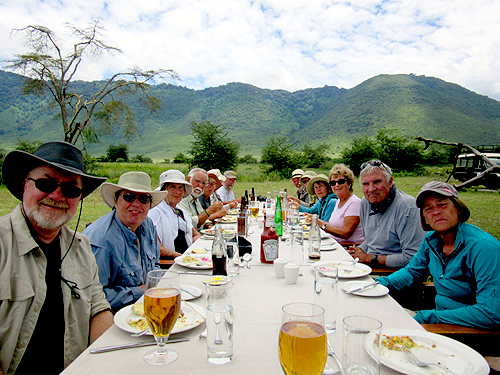
OnSafari: Tse-Tsed Tarangire
 Tarangire is the last place on earth for really big and wild elephants. We had amazing encounters.
Tarangire is the last place on earth for really big and wild elephants. We had amazing encounters.
We stayed in the southern part of the park where there are accommodations for only a few tourists. The vast majority stay to the north of Tarangire Hill.
So most of our time was spent in the south among hundreds if not thousands of the last great giants of the earth. Some were friendly enough that we could approach fairly closely. One wonderful family seemed almost oblivious to us: The matriarch was engrossed scratching herself on a tree.
Her little one-year old even managed to get on the other side of the tree and mimic her!
But most of our encounters in the south aren’t quite as peaceful. We had many trumpeting us, several charges and many times had to keep our distance to avoid disturbing them.
Part of the reason for their anxiety is that there’s just too many of them. The elephant density is so great today in northern Tanzania that normal elephant behaviors are breaking down. Families have no choice but to spend some time near one another, something they didn’t do when there weren’t so many.
OnSafari: Tarangire
OnSafari: Mara & Maasai
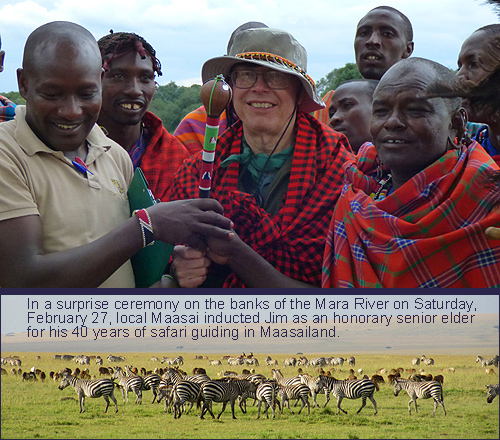 Our three days of game viewing in the Maasai Mara proved this is the most exciting place to experience extraordinary drama in Kenya.
Our three days of game viewing in the Maasai Mara proved this is the most exciting place to experience extraordinary drama in Kenya.
Many of the best wildernesses of East Africa are inextricably linked to the Maasai people. The three days of exciting game viewing in Kenya’s Maasai Mara impressed me especially for the simple fact that local Maasai have allowed this wild and wooly place to continue to exist.
Our nights at Governor’s Camp were not peaceful. Screaming baboon, howling hyaena, fighting elephant, roaring lion and grunting leopard even woke me, and some of my clients were actually concerned their first night or two.
As throughout all of northern Tanzania and very southern Kenya, there are too many elephant, and too many means more fights among them, day and night. We suffered two mock charges, one by a collared male that had been relocated after harassing residents of Nairobi.
The salient just outside Governor’s Camp is peppered with lion. We had the remarkable fortune to watch a three-day saga that began when a dead hippo “popped.”
Nothing kills or really wants to eat hippo. It’s too big, too fat and the hide, too thick. But a giant one of probably 3000 pounds or more died on the banks of the Mara River just outside Governor’s probably a few weeks before we arrived.
It ripens and then pops. It did so when we arrived, and we watched several giant crocs open “tunnels” into the fermenting beast.
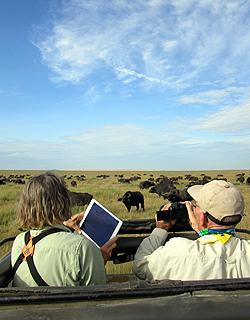
They didn’t get much to eat before one of the local lion prides displaced them and began gorging on the meat deep below the hide and fat that was finally available.
That drew hyaena and the hyaena drew birds and for the next two days we watched an endless drama of dozens of lions feasting and fighting and fending off literally 30 hyaena, not to mention the 14-foot crocs at river’s edge.
When the lions could just not stuff down another morsel, most of them went away, but as lion prides are want to do, one remained behind stuffed to the trimmings to “guard” the kill. She managed this for almost a day before submitting to her own need to sleep off the gluttony.
The hyaena pounced on the remaining carcass screaming and laughing and seriously fighting with one another. Vultures grabbed bits of meat and fat out of the air that were being flung from this giant holiday meal from hyaena completely inside the carcass!
That, my friends, was only one of dozens of exciting experiences this amazing reserve afforded us all. Quite far from Governor’s at Double Crossing we watched three lions stage a hunt of warthog from start to finish, leaving their 4 four-month old cubs sitting in a line about 5 feet from our cars.
We saw the most amazing assemblage of animals: topi, hartebeest, wildebeest, giraffe, waterbuck, eland, Grant’s and Thomson’s gazelle and probably others I’ve forgotten, strung across the unbelievably beautiful rolling hills of the Mara.
We watched the giant martial eagle attack guinea fowl. We saw two male impala sadly stuck together at their horn after a vicious fight. We watched hundreds of buffalo stampede through the waving tan oat grass, white egrets flung about them like fluff exploding from a pillow. We saw a mammoth hippo start to attack a Landrover.
And we watched amazing bird events, including maybe a thousand Abdim storks take off for their return journey to Europe easily circling up six or seven thousand feet in all but a few seconds.
It’s breathtaking being in The Mara. Always has been and always will… if the Maasai say so. Because all around the Mara are Maasai farms and businesses. We saw them. We followed a wild black rhino out of the park onto their land.
Running a farm or a small shop or teaching in school with too many elephants outside and lions threatening your livestock isn’t easy. Tourism and its benefits manages a fragile balance with this tolerance.
Let’s hope it continues.
OnSafari: The Mara
OnSafari: Resplendently!
 Rare and beautiful. That’s Samburu.
Rare and beautiful. That’s Samburu.
I’m finishing this blog atop a jutting mountain overlooking at least 500 square miles of the Great Northern Frontier. It would be easy to think I was overlooking a secret little national park in Utah or Arizona. But there are no airplane or car sounds, only the sounds of the crested francolin announcing the sunrise, and the very distant groans of lion returning from an evening’s hunt.

Several times during our three days here I saw my favorite bird: the golden breasted starling. The bird field guide calls it “resplendent, wild, restless and unapproachable.” That’s Samburu. That’s where we are now.
There are five unique life forms in Samburu and today we found them all!
The reticulated giraffe, the blue-legged Somali ostrich, the gerenuk, the Grevy’s zebra and the oryx. The oryx and gerenuk can be found, rarely, in other southern parks, but the other three are wholly endemic to this area.
And by the way, we also had a wonderful experience with two leopards!
I can’t help but thinking that our enormous success game viewing here has to do with how few tourists there are. Not too many years ago we would have had 30 cars around the leopard. Today, we were two of five.
The rest of the special animal attractions we found all by ourselves, with none others to share even if we wanted to.
Kenyan tourism remains sorely depressed. Many lodges are at the brink of bankruptcy. Special unimaginable deals are now available for last-minute bookers.
At the same time this group has such a remarkably positive attitude and is untiringly persistent. We’d not found the ostrich or zebra after a long but wonderful six hour early morning game drive. So after our brunch set up in a grove of doum palms was over, the plan was to return to camp.
Not this group! On we went and within a half hour we’d found the ostrich and another half hour we’d found Samburu’s greatest prize of all, the very endangered Grevy’s zebra.
Samburu’s unique big game is because of its geographical isolation in the near desert environment of the Great Northern Frontier. Once this area was as lush and rainy as those not too far north, and when that changed thousands of years ago, the animals that were captured here by a changing geography speciated.
They need less water and they regulate heat much better than their distant cousins to the south. And for many of us, they’re more beautiful!
The reticulated giraffe’s distinct markers present a major contrast with its pure white background. The ostrich has deep blue, rather than red legs during breeding.
A quarter way through my marathon 40th Anniversary of Guiding Safaris-safari, we prepare now to leave this magical place for still another of my favorites, the Maasai Mara. Stay tuned!

OnSafari: Great Northern Frontier
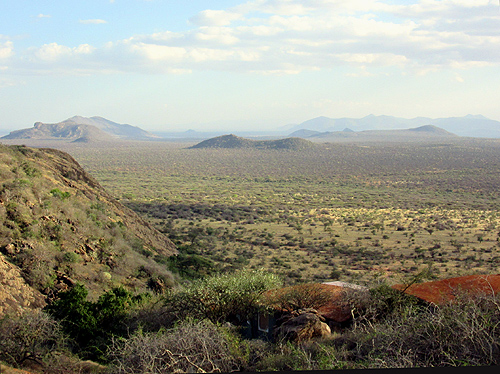
In two days we’ve seen reticulated giraffe, gerenuk, elephant, lion, a leopard kill (without the leopard, we were just minutes late) and are enjoying some of the most expansive vistas Africa can provide.
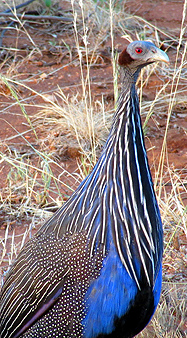
After yesterday’s wonderful drive around Mt. Kenya (which hasn’t once seemed to disappear from the skyline) we pulled past Isiolo and even Archer’s Post and continued on the desolate desert road north.
But not for long. Within a half hour we’d turned into the private Kalama Conservancy, a community based reserve that adjoins Samburu National Park. Eight villas are built on a steep mountain about a thousand feet above the mojave like desert of this incredible Northern Frontier.
Our first game drive within the conservancy found elephant and the reticulated giraffe, found only in these northern areas. It’s a beautiful, more colorful giraffe than the common one found most everywhere else, with additional horns and darker, very articulated markings.

Gerenuk were everywhere. That’s the weird long-necked antelope with an ET-head and giant ears.
Last night we went to bed under a starlit sky with a full moon that laid on the enormous landscape like a silk veil. Hyaena swooned and nightjars piped all night long. In the morning genet cats joined us in our individual villas to share the chocolate cookies of early morning tea.
Then this morning we left at 6 a.m. in the dark but with the full moon still radiant above, Jupiter just below it, Mars and Venus also visible. We encountered many elephant and giraffe as we entered Samburu National Park.
We set up breakfast on the river shore and watched two lionesses on the opposite bank, obviously irritated with an unsuccessful night of hunting. Honey badger tracks were all over our sandy knoll.
Under the towering doum palms at riverside we increased our bird sightings to the highest level I’ve ever achieved on a safari of this length so far: just under 400 species. Today we added the palm nut vulture, rosy-patched shrike, magpie starling and white-headed mousebird among many others. We saw lots more of the remarkable vulturine guinea fowl.
But the most amazing bird sighting of all was our own North American Northern Wheatear, a small thrush like bird that makes the longest migration on earth, even greater than the arctic tern. Some of the birds migrate 30000 km per year, from North America via Asia to here in Samburu. Their migration is so long that they spend more time migrating than in either their breeding or wintering grounds.
There are many luxury lodges in Kenya, but few this remote. It’s an outstanding place with incredible rooms, outstanding food and drink and a remarkable staff.
I am singularly impressed, in fact, with the Samburu staff. Their knowledge of the area is unmatched, of course, but who would have suspected the guides would know the Latin names of birds?
I was astounded to learn that all of them had rarely left this place, and that their entire education was from government schools in the area. Frankly, I think several of them would be better managers than the white faces that owners feel compelled to provide as a welcome.
The current South African couple (actually a Californian who married a South African) is incredibly nice, but they don’t know the language or Kenya. They’ve been here for less than a month having come from a presumably successful stint running a dive resort in Malaysia.
So I hold nothing against this wonderful couple. But it’s time Kenyan lodge owners understand that Kenyans, not wazungu, should manage their properties.
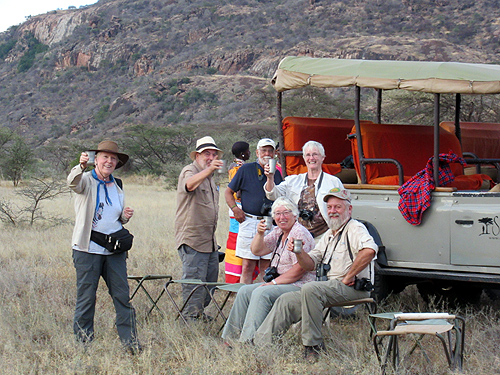
OnSafari: Aberdare
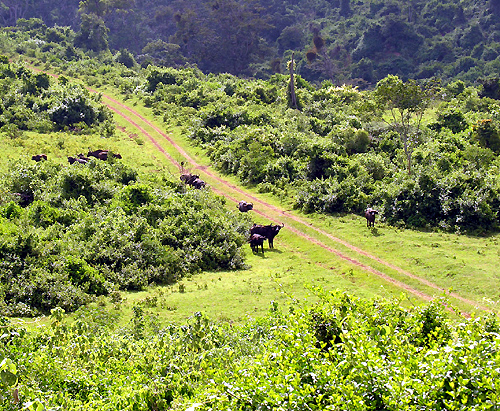 Absolutely Kenya’s greatest attraction is how different one day can be from the other. In all my 40 years guiding, no place changes so radically. It’s magic:
Absolutely Kenya’s greatest attraction is how different one day can be from the other. In all my 40 years guiding, no place changes so radically. It’s magic:
After a week in hot, humid semi-arid bushveld bingo!: we’re in the frost of a precious highland rain forest! Astounding.
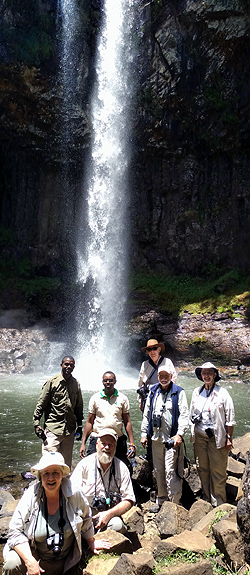
Our last two days were in a spectacular jungle but a cold one among rare monkeys and dinosaur-like birds.
The drive from Nairobi was an eye-opener. Veterans to Kenya in the last ten years would not recognize how massive Nairobi has become or how modern its transportation system now is: Six lanes of super highway took us out of the city.Practically every kilometer along the way featured skyrocketing apartment buildings, malls and the still present ramshackle duka. It’s a scene of development hard to comprehend.
Our first day was at the Aberdare Country Club, sister hotel to The Ark tree hotel. I was sincerely impressed by them both. Despite the depressed tourism Kenya has suffered these last 6-8 years, the owners have refurbished both places with new, modern bathrooms and better furnishings.
The country club is situated on one of the most beautiful sites in Kenya, high in the mountains with grand views everywhere. Massive amounts of bougainvilleas and other flowering trees attract dozens of sunbirds and giant mountain birds like the turaco and silvery-cheeked hornbill.
The grounds are teaming with slightly tamed game. Warthog, bushbuck, eland, baboon and colobus monkey lounge on the gorgeous grounds or simply come walking down your pathway!
Jim Pease, Shirley Gangwere and Kakkie Cunningham went horseback riding, and this was no ordinary ride! They trotted among giraffe and zebra!
The second day we went deep into the park and enjoyed a picnic lunch beside Chania waterfalls at around 11,000′. There was a lot of huffing and puffing getting down and then up from the waterfalls at that altitude, but it was worth it! The scenery was fabulous and a variety of unusual plants filled the forest.
On the way back I saw a track I didn’t recognize, so … well, we took it. We passed several beautiful little salt pans, each one surrounded by buffalo. We saw elephant and bushbuck as well, and once again this wonderful birding group found some special species like the alpine chat and mountain iladopsis.
The Ark has been made much more comfortable than when I was last here 5 years ago. Rooms are bigger, bathrooms are modern and the beds new. But the waterhole hasn’t changed, and we watched giant forest hog fend off hyaena and elephant families fight one another for the precious salt.
The full moon shown over Mt. Kenya and reflected onto The Ark’s pool. It was idyllic beyond belief.
Now, on to Samburu!
